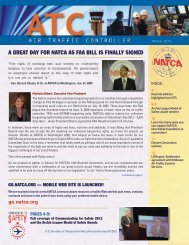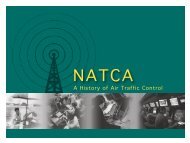Against the Wind - National Air Traffic Controllers Association
Against the Wind - National Air Traffic Controllers Association
Against the Wind - National Air Traffic Controllers Association
You also want an ePaper? Increase the reach of your titles
YUMPU automatically turns print PDFs into web optimized ePapers that Google loves.
from a couple of associates who declared <strong>the</strong> trust to<br />
be sound. O<strong>the</strong>r board members were leery. Several<br />
thought it sounded like a pyramid scheme. But <strong>the</strong>y<br />
never<strong>the</strong>less approved it as a membership benefit in<br />
<strong>the</strong> fall of 1988.<br />
Their fears proved correct a year later. The<br />
plan’s promoters claimed that NATCA’s initial contribution<br />
would be 5.35 percent of dues and never<br />
exceed 10 percent. However, consultant Joe Kilgallon<br />
discovered <strong>the</strong> union would need to allocate at<br />
least 20 percent to make <strong>the</strong> plan financially viable.<br />
An embarrassed NATCA sued and was able to recover<br />
all contributions as well as most of its legal<br />
and actuarial costs.<br />
Ano<strong>the</strong>r Mullin proposal has lived a long and<br />
useful life. Early on, he successfully persuaded <strong>the</strong><br />
board to set aside 6 percent of income as a contingency<br />
fund. Known as <strong>the</strong> “Southwest Rule,” Mullin’s<br />
budgetary foresight proved invaluable in 1998. By<br />
<strong>the</strong>n, <strong>the</strong> fund had swelled to $800,000 and enabled<br />
NATCA to avoid going into debt as it spent heavily to<br />
finish a facility reclassification project and complete<br />
its third contract with <strong>the</strong> agency. That same year, <strong>the</strong><br />
Southwest Rule was reduced to 4 percent of income.<br />
Although dues revenue grew as membership<br />
climbed, NATCA’s first two years were awash in red<br />
ink, forcing <strong>the</strong> union to borrow ano<strong>the</strong>r $400,000<br />
from MEBA in July 1989. Regional reps using a common<br />
credit card occasionally had to dig for o<strong>the</strong>r<br />
6<br />
means of payment when merchants rejected <strong>the</strong><br />
union plastic.<br />
Spickler, who was in charge of finances, grew<br />
so concerned about expenses that he finally told Bell,<br />
“Nobody can buy a paper clip in this office unless I<br />
approve it.” Bell instituted “mini-minutes”—summaries<br />
of <strong>National</strong> Executive Board meetings reduced<br />
on a photocopier to save paper. Those with less than<br />
perfect eyesight could barely read <strong>the</strong>m.<br />
Aside from <strong>the</strong> additional loan, MEBA agreed<br />
to halve its 15 percent affiliation fee for six months<br />
shortly after <strong>the</strong> first <strong>National</strong> Executive Board took<br />
Feb. Feb.<br />
Samuel Skinner takes over as transportation secretary from<br />
James H. Burnley. Skinner, an Illinois lawyer, served as chairman<br />
of <strong>the</strong> state’s Regional Transportation Authority.<br />
17<br />
Chapter 4: The House that NATCA Built<br />
NATCA archives<br />
Paying off <strong>the</strong> debt: Strapped for cash in its early years, NATCA’s finances quickly improved. In October 1995, President<br />
Barry Krasner, right, and Executive Vice President Michael McNally presented MEBA with a final loan payment.<br />
111<br />
FAA Administrator T. Allan McArtor leaves office after serving<br />
since July 22, 1987.




